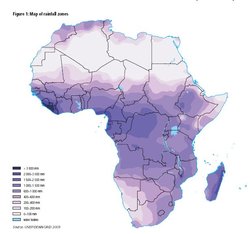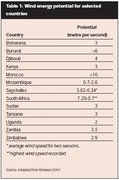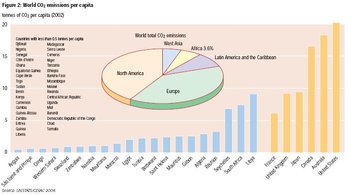Atmospheric resources in Africa
Contents
Regional Synthesis
Africa is endowed with diverse and abundant atmospheric resources. These resources include rainfall, air, solar radiation or insolation, and wind. Unlike land and marine resources, atmospheric resources are found in all African countries, although at varying levels, distribution and frequency.
Atmospheric resources provide life-supporting goods and services. The air contains oxygen, carbon dioxide and nitrogen that are essential for life and livelihoods. The clouds, with their accompanying lightning phenomenon and rainfall, play a critical role in supporting life on Earth. Rainfall is a source of water for people, animals and plants, and for rain-fed agriculture. The ozone layer, found in the stratosphere, protects human beings from ultraviolet radiation that is likely to cause cancer. Solar insolation (Earth-Sun relationships and insolation) provides light and energy. The sun, wind and rivers are sources of energy for direct use or electricity generation.
The northern and southern countries in Africa receive little rainfall, below 1,000 mm per year. The equatorial countries receive over 1,000 mm of rainfall on average. Higher-speed winds are generally found in the southern and northern parts of the continent. Virtually all countries in Africa receive over ten hours of sunshine a day, providing good potential for solar energy generation. The air in Africa, except in major industrial cities, is relatively clean.
Atmospheric resources offer a variety of opportunities for sustainable development. Air pollutants including soot and dust, greenhouse gases (GHG), chlorofluorocarbons (CFCs), and heavy metals affect the quality of air and threaten the goods and services provided by the atmosphere. These pollutants contribute to climate change, climate variability, depletion of the ozone layer, and low air quality. Climate variability and climate change manifest themselves in global warming, and extreme weather events including floods, droughts, heat waves and typhoons. These phenomena affect human well-being through increasing the incidence of diseases, affect land and marine productive systems from which livelihoods are derived, and destroy infrastructure.
Thus, threats to atmospheric resources undercut development opportunities. Mitigating the causes and impacts of potential threats is important — Africa needs to develop appropriate policy and action. Investing in programs and businesses that mitigate the effects of climate variability, climate change and air pollution presents opportunities for sustainable development. There are also benefits that can be derived in reversing degradation of atmospheric resources.
Inventory of resources
Rainfall and rivers
Africa has virtually the same climatic zones in the northern and southern hemisphere, and these zones are arranged symmetrically on either side of the equator. The zones are determined mainly by latitude, except in the east where highlands greatly modify the climate. Africa is predominantly a tropical region: only its northern and southern extremes, which are directly influenced by mid-latitude westerly [[wind]s], are considered to have temperate climates. Nevertheless, it is, after Australia, the driest region in the world. The amount, duration and seasonal distribution of rainfall are the most important factors differentiating its climates. Africa has six climatic zones. These are equatorial, savannah, semi-arid, arid, highland and Mediterranean:
- Equatorial climates occur close to the equator in the west and the central parts of Africa, and in eastern Madagascar. Rainfall is high, typically exceeding 1,500 mm per year and as much as 3,200 mm in some places. Rainfall occurs in every month, and many areas experience two rainy seasons per year.
- Tropical savannah climates occur north and south of the tropical wet zone, in much of west and southern Africa, and in most of Madagascar. This climatic zone is marked by a well-defined dry season of three to eight months. Annual rainfall is usually between 500 and 1,500 mm, although limited areas have considerably more: for example, Freetown in Sierra Leone averages 3,800 mm per year. The tropical savannah zone is a transitional zone between tropical wet and semi-arid zones, so there is a progressive decline, moving towards the poles, in total rainfall and the duration of the rainy season. Areas with a longer rainy season tend to have two rainy periods separated by a short dry spell, while areas with a shorter rainy season have a single rainy period.
- Surrounding the tropical savannah climate zone are areas of semi-arid, and then arid climates in the west, north-central, east-central and southern parts of Africa. The semi-arid zone has a short rainy season of up to three months, with about 250-500 mm of rainfall per year. Precipitation is unreliable and scarce.
- Tropical highland climates are common in much of east Africa. In most parts of the world, higher elevations receive higher levels of precipitation, but the highlands of east Africa are an exception, experiencing rather low levels of rainfall. However, the highest mountains and the south-eastern flank of the Ethiopian plateau receive greater precipitation on their windward slopes.
- The coastlands of the Cape in South Africa and the north African coast, from Morocco to Tunisia, have Mediterranean climates. These areas have mild, rainy winters followed by a prolonged summer when conditions are warm and dry. They receive between 250 and 1,000 mm of rainfall per year.
Most of the African continent receives moisture from air originating over the Atlantic Ocean. In the eastern part, however, rainfall south of the equator comes from large tropical cyclones originating over the Indian Ocean during the southern hemisphere summer. Rainfall from these cyclones is particularly high in eastern Madagascar and the coastal mainland between South Africa and southern Tanzania.
Average rainfall has decreased since 1968, and has been fluctuating around a notably lower mean. In Africa, some 3,988 km3 of renewable water is available annually. In recent years, the pattern of rainfall has tended to extremes, with the severity and frequency of droughts and floods increasing.
Africa has many rivers, but some, particularly in the mountainous areas, are seasonal and the water flow rates are gradually declining over the years.
The major rivers include the Senqu or Orange, Niger, Zambezi, Limpopo, Senegal, Congo and the Nile. The Nile is the longest river in the world, at about 6,679 km. The Nile starts from Lake Victoria and passes through Uganda, Sudan and Egypt to the Mediterranean Sea. The main headstreams, the Blue Nile and the White Nile, join at Khartoum in Sudan to form the Nile proper. The Senqu/Orange River is 2,092 km long and passes through Lesotho, South Africa and Namibia, flowing south-west, north-west, and west to the Atlantic Ocean. The Niger River is found in Western Africa, rising in Guinea and flowing about 4,183 km in a wide arc through Mali, Niger and Nigeria to the Gulf of Guinea. The Zambezi River is about 2,735 km long, rising in northwest Zambia and flowing south and west to the Mozambique Channel. The Limpopo River runs through South Africa, flowing about 1,770 km in a north-east-south-east arc to the Indian Ocean in southern Mozambique. The Congo River is 4,666 km long and flows through Congo and the Democratic Republic of the Congo to the Atlantic Ocean. The Congo, which alone accounts for some 38 percent of the continent’s discharge into the ocean, drains an area of more than 4.1 million km2, ranking second only to South America’s Amazon River in terms of discharge and size of drainage basin. The Congo River basin alone holds almost 30 percent of Africa’s total fresh surface water reserves and the world’s largest hydropower potential in any one single river basin. Africa’s rivers provide extensive hydropower potential including for large (> 500 MW), medium (> 10 MW, < 500MW) and small (< 10 MW) plants.
Wind and solar resources
Africa has traditionally relied on woody biomass for energy. Declining forest and woodland resources creates new challenges for meeting energy needs. Africa’s rate of deforestation, at 0.8 percent per year, is the highest in the world: between 1990 and 2000 an average annual loss of 5,262,000 hectares (ha) per year was incurred. There are no reliable statistics on the extent to which other biomass, such as farm and urban waste, is available for energy. In this context, wind and solar energy are particularly important.
Low wind speeds prevail in many African countries, particularly in those that are landlocked. South Africa has some of the highest wind potential in the region. For example, wind speeds of 7.2 to 9.7 meters per second have been recorded around Cape Town and Cape Agulhas. Northern Africa’s coast also experiences optimal wind speed, especially Morocco. Other countries in Africa have relatively low speeds, as shown in Table 1.
Africa is endowed with enormous potential for solar energy generation; the actual potential depends on how its primary solar energy is converted into a useable resource such as through photovoltaic cells or power-concentrating technologies. Concentrating solar power technologies use reflective materials, such as mirrors, to concentrate the sun’s energy and direct it into a thermal receiver, and can be used to provide heating and lighting. Photovoltaic technologies use light to produce electricity. Estimates of the globally available solar energy is more than adequate to meet current and projected energy needs up to 2020. For Sub-Saharan Africa (SSA), the minimum estimated solar energy is 371.9 exajoules and the maximum is 9,528 exajoules.
Air
Africa’s air is relatively clean. However, pollution is an emerging issue in urban centers and is already a problem in major industrial cities, like Cairo, Egypt. The air is polluted by emissions from industry, motor vehicles and households, including oxides of sulfur, carbon, nitrogen, particulates, lead and organic compounds. Because of the reliance of many households on woody biomass for energy, indoor pollution is a concern. This has a disproportionately high impact on women and children.
Industrialization is taking root in many countries, and this, along with the increasing number of households, is putting pressure on the quality of air. In the transportation sector, the excessive use of second-hand vehicles and poor maintenance of vehicles are major contributors to air pollution. The use of leaded fuel is also a contributor. However, Africa contributes only 3.6 percent of global emissions of carbon dioxide, the principal gas linked with global warming.
Conclusion
Atmospheric resources are essential for the maintenance of life and human well-being, and they provide multiple opportunities for development. Atmospheric resources are transboundary resources and are affected by global, regional and national practices. The unsustainable management of these resources – at the global, regional, sub-regional and national levels – have implications for development and livelihoods in Africa. This is most acutely felt in activities directly dependent on natural resources and processes such as agriculture. Thus partnerships at multiple scales are critical to addressing the challenges and maximizing opportunities.
Policy interventions are necessary to remove barriers to investments in renewable energy resources and mitigation of impacts of climate change, extreme weather events and air pollution. Policy objectives should promote investments in businesses and projects which contribute to sustainable development whilst conserving the value and quality of atmospheric resources. African governments are called upon to bridge the gap between the existing information and policy actions. Policies should be translated into laws and regulations as a strategy to ensure implementation and smooth governance of the use of atmospheric assets.
Poor access to modern environmentally sound technologies, lack of capacity to develop or acquire technology, and restrictions imposed by developed countries, contribute significantly to denying African people the opportunity to use atmospheric resources. Barriers that contribute to low use of modern technologies in exploiting renewable energy resources include lack of information, high capital cost of renewable energy supply systems, the intermittent nature of renewable energy resources, site-specific constraints, and poor access to modern technologies.
Harmonizing policy interventions across sectors is critical given the close relationship between energy, consumption and production patterns, environmental management and climate change. This involves building cooperation between different stakeholders. The value of such an approach is discussed Interlinkages: Environment and Policy Web in Africa. Planning and setting clear targets is important, especially regarding a shift to renewable energy. Formulating and enforcing standards in relation to equipment as well as pollution is crucial. The implementation of MEAs through policies and programmes designed to meet their objectives and targets can be an important complement to national activities. These MEAs include UNFCCC and its Kyoto Protocol, as well as the Montreal Convention. Developing capacity for early warning systems is crucial given the wide-ranging impacts of climate variability. This must be coupled with effective response systems.
The key to successful policy interventions is political will, as expressed in the following quote:
“The reductions in poverty in both countries And China are primarily the result not of the policies of the global great and good, or of the charity of rich countries, but of better domestic government – including the provision of basic education and health care and, crucially, the freeing up of markets. In both countries, even better government would reduce poverty further. For instance, corruption remains rife in both countries, and has a particularly severe impact on the poor by depriving them of needed services and raising their cost of access to markets and to finance” (Economist 2004).
Further Reading
- ECA, 2000. Transboundary River/Lake Basin Water Development in Africa: Prospects, Problems, and Achievements. ECA/RCID/052/00. United Nations Economic Commission for Africa, Addis Ababa.
- FAO, 2005. State of the World’s Forests 2005. Food and Agriculture Organization of the United Nations, Rome.
- Gordon, B., Mackay, R. and Rehfuess, E., 2004. Inheriting the World: the Atlas of Children’s Environmental Health and the Environment. World Health Organization, Geneva.
- Karekezi, S., 2001. The potential of renewable energy technologies in Africa. Working Paper No. 273,AFREPREN/FWD. African Energy Policy Research Network.
- Pickett, J. (ed.), 2000. The American Heritage® Dictionary of the English Language, 4th ed. Houghton Mifflin, Boston.
- Rogner, H., 2000. Chapter 5: Energy Resources. (Atmospheric resources in Africa) In World Energy Assessment: Energy and the Challenge of Sustainability (ed. Goldemberg, J.), pp. 135-71. United Nations Development Programme, New York.
- UNEP, 1999. Global Environment Outlook-2000. United Nations Environment Programme, Nairobi.
- UNEP, 2006. Africa Environment Outlook 2.
|
|
| Disclaimer: This article is taken wholly from, or contains information that was originally published by, the United Nations Environment Programme. Topic editors and authors for the Encyclopedia of Earth may have edited its content or added new information. The use of information from the United Nations Environment Programme should not be construed as support for or endorsement by that organization for any new information added by EoE personnel, or for any editing of the original content. |


